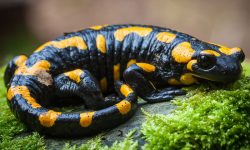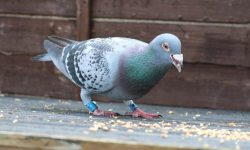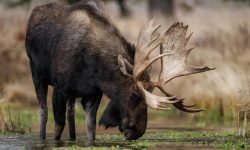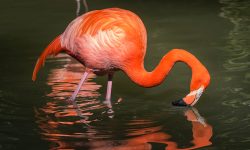Robins are among the most familiar songbirds in North America and Europe, often spotted hopping across lawns, perched on fences or singing from tree branches. Their bright orange breasts and energetic movements make them easy to recognize, and their feeding habits reveal how adaptable and resourceful they are throughout the year. Understanding what robins eat provides insight into how these birds survive seasonal changes, migration, breeding and harsh weather.
Robins rely on a balanced diet of insects, worms, fruits and occasional seeds. Their feeding style shifts dramatically depending on the season. During spring and summer, they focus on protein-rich prey that fuels breeding and chick development. When colder months arrive and insects become scarce, robins switch to berries and winter fruits that remain on shrubs and trees. This dietary flexibility allows them to thrive in forests, grasslands, parks and urban neighborhoods.
This guide explores 20 wild foods robins rely on, revealing how these small birds find nourishment in every season, maintain their energy for long flights and contribute to the ecosystems they inhabit.
Understanding the Robin Diet
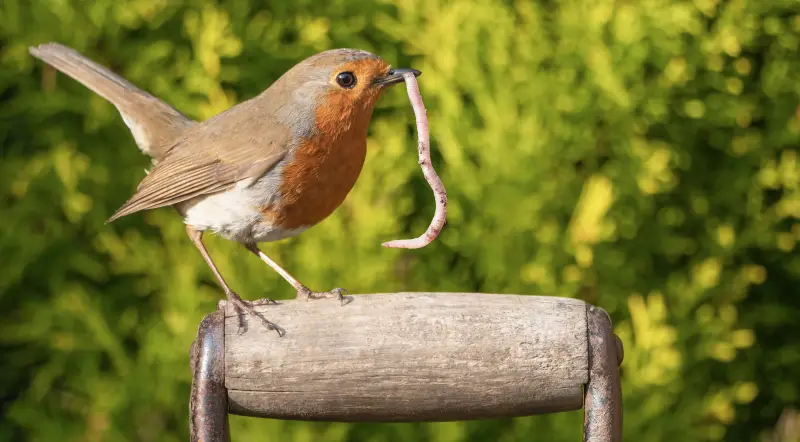
Robins are omnivorous, but insects and invertebrates make up the majority of their warm-season diet. Their sharp eyesight helps them detect movement on the ground, while their agile bodies allow them to hop quickly across lawns or forest floors in search of prey. They listen for vibrations and surface disturbances, using sound to locate worms hiding underground.
During fall and winter, robins rely heavily on fruits. Their digestive system handles berries efficiently, and many winter fruits offer natural sugars that help robins maintain energy. These fruits also contain antioxidants and hydration, which are essential during cold, dry months.
Because robins migrate across vast regions, their diet must accommodate different habitats. Their ability to switch from protein-rich prey to fruit-based nutrition gives them the versatility needed to survive in constantly changing environments.
20 Wild Foods Robins Rely On
1. Earthworms
Earthworms are one of the most iconic robin foods. Robins use a combination of sight and hearing to detect worms beneath the soil. Their movements are precise and swift, allowing them to catch worms as they surface.
Earthworms supply high-quality protein and moisture, crucial during spring when robins recover from migration and prepare for nesting. Feeding on worms helps adult robins build strength quickly as temperatures warm.
Parents feed worms to their chicks due to their soft texture and easy digestion. This makes earthworms essential for early chick development.
2. Beetles
Beetles appear in gardens, forests and meadows, offering robins a dependable food source. Their crunchy exoskeletons contain valuable fats and protein.
Robins forage beetles by flipping leaves, inspecting tree bark or searching soil surfaces. Their quick reflexes allow them to catch beetles before they escape into cracks or vegetation.
Beetles provide slow-digesting nutrients that sustain robins during long periods of territorial defense or high activity.
3. Caterpillars
Caterpillars are soft-bodied and loaded with protein, making them ideal for feeding chicks. Robins hunt them by scanning branches and leaves for movement.
These larvae are abundant in spring and early summer, aligning perfectly with nesting season. Their high moisture levels help hydrate chicks that cannot yet drink water independently.
Caterpillars form a major portion of the diet for juvenile robins during their rapid growth phase.
4. Grasshoppers
Grasshoppers are a seasonal delicacy for robins. These insects provide large protein-packed meals, especially in open fields and grassy clearings.
Robins catch grasshoppers by hopping rapidly toward them and striking before the insect jumps. Their accuracy helps them secure these quick, agile prey.
During late summer, grasshoppers help robins build the strength needed for migration or territorial establishment.
5. Ants
Ants cluster in colonies along forest floors, sidewalks and garden edges. Their small size allows robins to consume multiple ants quickly.
Robins capture ants by pecking at soil clumps or feeding near anthill entrances. Ants offer minerals and protein that support energy metabolism.
Though not a primary food, ants supplement the robin diet during active foraging periods.
6. Spiders
Spiders are easy for robins to capture and digest. They contain valuable hydration and nutrients, including essential amino acids.
Robins search for spiders under logs, leaves and rocks. Their quick beaks allow them to capture spiders without allowing escape or retaliation.
Spiders become especially important when insect availability declines during weather changes.
7. Snails (Small)
Small snails appear in moist environments after rainfall. Robins break shells or swallow very small snails whole.
Snails provide calcium that helps strengthen bones and eggshells. Female robins especially rely on calcium-rich foods before laying eggs.
Snails also offer hydration, making them beneficial during dry summers.
8. Fruit-Bearing Shrubs
Robins feed on berries from shrubs like serviceberry, mulberry and chokeberry. These shrubs produce fruits that remain edible through fall.
Ripened fruits provide natural sugars that fuel migration and cold-weather survival. Robins pluck fruits directly from branches or pick fallen ones from the ground.
The bright colors of these berries attract robins from long distances.
9. Wild Grapes
Wild grapes grow in clusters along vines in forests and hedgerows. Their high sugar content supports long-term energy needs.
Robins devour grapes whole or peck them into smaller pieces. The hydration within the fruit helps robins cope with heat or long travel days.
Grapes become vital during late summer when insects begin to decrease.
10. Elderberries
Elderberry clusters attract large flocks of robins. These berries are rich in antioxidants, helping robins strengthen their immune systems.
Robins often gather in communal feeding groups during elderberry season. This social feeding helps robins locate abundant berry patches quickly.
Elderberries remain available into fall, offering extended nutrition.
11. Hackberries
Hackberry trees produce small, firm fruits that persist well into winter. Robins rely heavily on hackberries during cold months.
These fruits contain fats, carbohydrates and hydration that help robins maintain body warmth. Their long shelf life makes them one of the most important winter foods.
When snow covers the ground, robins often remain near hackberry trees for days.
12. Dogwood Berries
Dogwood berries offer dense nutrients needed for migration. Robins eat them whenever they ripen, usually in late summer and early fall.
These berries are soft, easily plucked and packed with sugars. Their red color visually attracts robins searching for high-energy fruit.
Dogwood berries strengthen robins during the physically demanding migration season.
13. Winterberries
Winterberries remain on bushes long after leaves fall, giving robins access to food during early winter when insects are gone.
Robins feed on these bright red berries to preserve energy in freezing temperatures. Their moisture content supports hydration when water sources freeze.
Winterberries often help overwintering robins survive cold snaps.
14. Sumac Berries
Sumac produces cone-shaped clusters of red fruits that robins eat during late fall and winter. These berries persist for months.
Robins pick sumac berries by clinging to branches or flying up to clusters. Their sour taste contains nutrients that support stamina.
Sumac is one of the last natural foods available before snow accumulates.
15. Blackberries
Wild blackberries provide a sweet, juicy treat for robins. They offer hydration and sugars that support migration preparation.
Robins land directly on brambles or eat fallen berries from below. Their beaks easily penetrate the soft fruit.
Blackberries also attract insects, creating additional feeding opportunities for robins.
16. Blueberries
Blueberries supply antioxidants and vitamins. Robins eat them throughout summer when bushes are full and fruit is abundant.
Blueberries provide natural hydration as robins travel between feeding sites. Their nutritional density supports muscle repair and feather maintenance.
Robins recognize blueberry patches year after year, returning to reliable feeding grounds.
17. Crabapples
Crabapple trees drop fruit during fall and winter. Robins feed on softened fruit or peck fresh fruit still hanging from branches.
These small apples provide valuable carbohydrates and moisture. Their sour taste doesn’t deter robins, especially during food shortages.
Crabapples sustain robins during long winter stretches when berries diminish.
18. Raisins (Naturally Dried Fruit)
In the wild, robins sometimes encounter naturally dried fruit fallen from trees or dried by sun. Dried fruits offer concentrated sugars.
These raisins deliver quick bursts of energy during intense activity such as territorial fights or migration fueling. Their sticky texture encourages robins to peck slowly and extract nutrients.
In drought periods, dried fruit becomes a secondary hydration source.
19. Seeds (Occasional)
While not primary seed-eaters, robins consume small seeds when other foods run low. They prefer soft seeds like wildflower seeds, thistle seeds or crushed grains.
Seeds help robins maintain calorie intake during seasonal transitions. Their small size allows robins to digest them easily.
Seeds play a minor but reliable role in the robin diet.
20. Beetle Larvae
Beetle larvae live underground or inside rotting logs. Robins search soil, leaf litter and decaying wood to find them.
Larvae are soft, nutrient-packed and easy for robins to digest. They provide high protein for nesting adults and growing chicks.
Larvae are especially important in early spring before insects fully emerge.
FAQs About What Do Robins Eat
What do robins eat most?
Earthworms, insects and berries depending on the season.
Do robins eat seeds?
Yes, but only occasionally. They prefer soft seeds over hard grains.
What do robins eat in winter?
Winterberries, crabapples, hackberries, sumac and any remaining fruit.
Do robins eat worms year-round?
They eat worms mainly in spring and summer when the ground is soft.
Do baby robins eat fruit?
No. Chicks eat worms and soft insects until they mature.
Do robins drink water?
Yes, and they also obtain moisture from fruits and insects.
Are robins omnivores?
Yes. They eat both animal prey and plant foods.
Why do robins visit lawns?
They search for worms and insects in moist soil.
Do robins eat from feeders?
Rarely—robins prefer natural foods.
What food helps robins during migration?
High-sugar fruits like dogwood berries and elderberries.
Final Thoughts
Robins survive and thrive across continents because of their adaptable diet and exceptional foraging skills. By relying on worms, insects, berries and occasional seeds, they maintain the energy required for breeding, migration and year-round activity. Understanding what robins eat gives us a deeper appreciation for these resilient songbirds and highlights the importance of protecting natural habitats that supply their essential foods.

